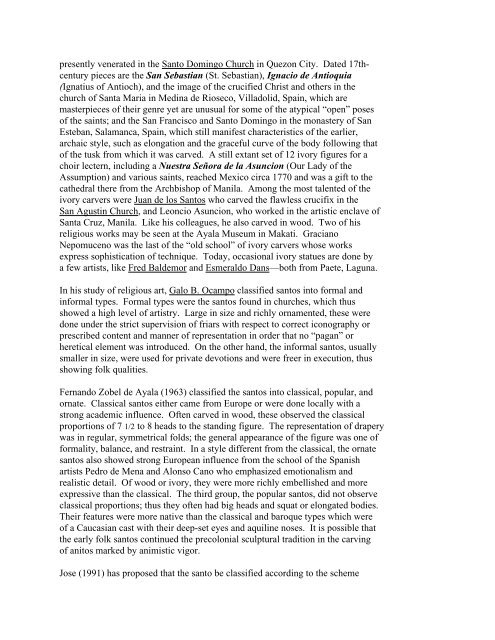SCULPTURE Sculpture is the art of making three-dimensional ...
SCULPTURE Sculpture is the art of making three-dimensional ...
SCULPTURE Sculpture is the art of making three-dimensional ...
You also want an ePaper? Increase the reach of your titles
YUMPU automatically turns print PDFs into web optimized ePapers that Google loves.
presently venerated in <strong>the</strong> Santo Domingo Church in Quezon City. Dated 17thcentury<br />
pieces are <strong>the</strong> San Sebastian (St. Sebastian), Ignacio de Antioquia<br />
(Ignatius <strong>of</strong> Antioch), and <strong>the</strong> image <strong>of</strong> <strong>the</strong> crucified Chr<strong>is</strong>t and o<strong>the</strong>rs in <strong>the</strong><br />
church <strong>of</strong> Santa Maria in Medina de Rioseco, Villadolid, Spain, which are<br />
masterpieces <strong>of</strong> <strong>the</strong>ir genre yet are unusual for some <strong>of</strong> <strong>the</strong> atypical “open” poses<br />
<strong>of</strong> <strong>the</strong> saints; and <strong>the</strong> San Franc<strong>is</strong>co and Santo Domingo in <strong>the</strong> monastery <strong>of</strong> San<br />
Esteban, Salamanca, Spain, which still manifest character<strong>is</strong>tics <strong>of</strong> <strong>the</strong> earlier,<br />
archaic style, such as elongation and <strong>the</strong> graceful curve <strong>of</strong> <strong>the</strong> body following that<br />
<strong>of</strong> <strong>the</strong> tusk from which it was carved. A still extant set <strong>of</strong> 12 ivory figures for a<br />
choir lectern, including a Nuestra Señora de la Asuncion (Our Lady <strong>of</strong> <strong>the</strong><br />
Assumption) and various saints, reached Mexico circa 1770 and was a gift to <strong>the</strong><br />
ca<strong>the</strong>dral <strong>the</strong>re from <strong>the</strong> Archb<strong>is</strong>hop <strong>of</strong> Manila. Among <strong>the</strong> most talented <strong>of</strong> <strong>the</strong><br />
ivory carvers were Juan de los Santos who carved <strong>the</strong> flawless crucifix in <strong>the</strong><br />
San Agustin Church, and Leoncio Asuncion, who worked in <strong>the</strong> <strong>art</strong><strong>is</strong>tic enclave <strong>of</strong><br />
Santa Cruz, Manila. Like h<strong>is</strong> colleagues, he also carved in wood. Two <strong>of</strong> h<strong>is</strong><br />
religious works may be seen at <strong>the</strong> Ayala Museum in Makati. Graciano<br />
Nepomuceno was <strong>the</strong> last <strong>of</strong> <strong>the</strong> “old school” <strong>of</strong> ivory carvers whose works<br />
express soph<strong>is</strong>tication <strong>of</strong> technique. Today, occasional ivory statues are done by<br />
a few <strong>art</strong><strong>is</strong>ts, like Fred Baldemor and Esmeraldo Dans—both from Paete, Laguna.<br />
In h<strong>is</strong> study <strong>of</strong> religious <strong>art</strong>, Galo B. Ocampo classified santos into formal and<br />
informal types. Formal types were <strong>the</strong> santos found in churches, which thus<br />
showed a high level <strong>of</strong> <strong>art</strong><strong>is</strong>try. Large in size and richly ornamented, <strong>the</strong>se were<br />
done under <strong>the</strong> strict superv<strong>is</strong>ion <strong>of</strong> friars with respect to correct iconography or<br />
prescribed content and manner <strong>of</strong> representation in order that no “pagan” or<br />
heretical element was introduced. On <strong>the</strong> o<strong>the</strong>r hand, <strong>the</strong> informal santos, usually<br />
smaller in size, were used for private devotions and were freer in execution, thus<br />
showing folk qualities.<br />
Fernando Zobel de Ayala (1963) classified <strong>the</strong> santos into classical, popular, and<br />
ornate. Classical santos ei<strong>the</strong>r came from Europe or were done locally with a<br />
strong academic influence. Often carved in wood, <strong>the</strong>se observed <strong>the</strong> classical<br />
proportions <strong>of</strong> 7 1/2 to 8 heads to <strong>the</strong> standing figure. The representation <strong>of</strong> drapery<br />
was in regular, symmetrical folds; <strong>the</strong> general appearance <strong>of</strong> <strong>the</strong> figure was one <strong>of</strong><br />
formality, balance, and restraint. In a style different from <strong>the</strong> classical, <strong>the</strong> ornate<br />
santos also showed strong European influence from <strong>the</strong> school <strong>of</strong> <strong>the</strong> Span<strong>is</strong>h<br />
<strong>art</strong><strong>is</strong>ts Pedro de Mena and Alonso Cano who emphasized emotional<strong>is</strong>m and<br />
real<strong>is</strong>tic detail. Of wood or ivory, <strong>the</strong>y were more richly embell<strong>is</strong>hed and more<br />
expressive than <strong>the</strong> classical. The third group, <strong>the</strong> popular santos, did not observe<br />
classical proportions; thus <strong>the</strong>y <strong>of</strong>ten had big heads and squat or elongated bodies.<br />
Their features were more native than <strong>the</strong> classical and baroque types which were<br />
<strong>of</strong> a Caucasian cast with <strong>the</strong>ir deep-set eyes and aquiline noses. It <strong>is</strong> possible that<br />
<strong>the</strong> early folk santos continued <strong>the</strong> precolonial sculptural tradition in <strong>the</strong> carving<br />
<strong>of</strong> anitos marked by anim<strong>is</strong>tic vigor.<br />
Jose (1991) has proposed that <strong>the</strong> santo be classified according to <strong>the</strong> scheme

















